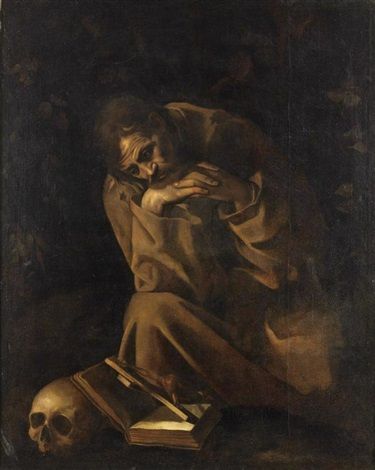תיאור
The painting "Saint Francis in Meditation", made by Caravaggio in 1606, is a work that encapsulates the essence of tenebrism, a technique that the artist masterfully Italianized to enhance the drama of his compositions. This work is a clear example of the introspective and spiritual approach that characterizes the saint, with a moving representation that suggests a deep connection with the divine. Caravaggio manages, through his lighting technique, to project the light in such a way that it highlights the most relevant characteristics of his protagonist, the Franciscan friar.
In this work, St. Francis appears in a state of contemplation, seated on a dark-colored cloak that contrasts with the clarity of the saint's face and hands. The light focuses on his face, which shows an expression of serenity and inner peace, while reflecting suffering and total surrender to God. Caravaggio, known for his ability to capture the subtleties of human emotions, uses light not only as an aesthetic medium, but also as a narrative device that emphasizes the spiritual state of his central figure. The nuances of light and shadow create an almost ethereal atmosphere, suggesting the transition between the earthly and the divine.
The background of the painting is dark, which enhances the effect of a luminous halo surrounding Saint Francis. This use of chiaroscuro is characteristic of Caravaggio's style, who challenges previous artistic conventions and finds in the duality of light and shadow a vehicle to explore human nature and its relationship with the divine. The choice of background aligns with the master's practice of focusing the viewer's attention on the main figure, eliminating distracting elements and creating a sacred space that invites reflection.
Interestingly, in the corner of the composition, we can notice a small skull, a symbol of the memento mori that Caravaggio includes to remind us of the transience of life and the inevitability of death. This inclusion adds a layer of meaning that invites the viewer to reflect on existence and spiritual transcendence, a recurring theme in Caravaggio's work, which frequently explores the sacred and the profane.
"Saint Francis in Meditation" is part of the evolution of Baroque art, where the artist's intimate gaze on his subject and the raw representation of reality come together to create an emotionally resonant experience. The work falls into a line of other depictions of St. Francis by different artists, but it is Caravaggio's interpretation that manages to capture the saint's spiritual longing so viscerally.
The work, though less well-known than his major masterpieces such as The Death of the Virgin and The Calling of St. Matthew, remains emblematic of Caravaggio's genius, whose innovations in the use of light and color laid the groundwork for generations of artists. St. Francis in Meditation is undoubtedly a window into the psychology and spirituality of his time, and an invitation to join in contemplation of the divine, an inherent aspect of the human experience that Caravaggio captured in a transcendent way.
KUADROS ©, a famous painting on your wall.
Hand-made oil painting reproductions, with the quality of professional artists and the distinctive seal of KUADROS ©.
Painting reproduction service with satisfaction guarantee. If you are not completely satisfied with the replica of your painting, we will refund 100% of your money.

